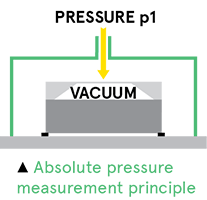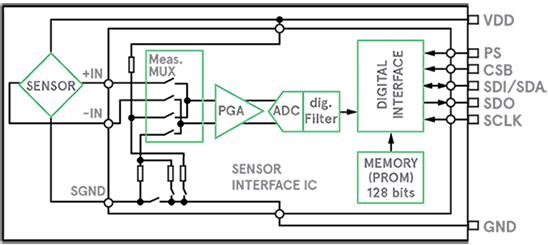Take the Poll | Join our Discussion
sponsored by

The Advancement of Smart Sensor Technology
The advancement of technologies such as edge computing, the Internet of Things (IoT), and Big Data analytics are enabling the development of smart factories, or Industry 4.0. Many industrial devices are now capable of running autonomously, due in part to smart sensors. Smart sensors can detect, analyze, and process information, including changes in position, temperature, and pressure, allowing devices to automatically adapt to different situations. Smart sensors include several connectivity options, and many have built-in sensor diagnostics. This article focuses on smart pressure sensors, which are widely used in industrial applications, such as air conditioning, hydraulic measures, predictive maintenance, and altitude and liquid pressure monitoring.
What is a Smart Sensor?
A smart sensor is a device that collects data from a physical environment and processes it using integrated compute resources. Figure 1 depicts the typical process of a smart sensor, as it transmits data to a gateway via linked networks.

Figure 1: Building Blocks of a Smart Sensor
An integrated microprocessor unit (MPU) manages the application software and algorithms. The MPU can run filtering, compensation, and other process-specific signal conditioning tasks. The software also enables the digital interfaces that make the sensor capable of communicating with external devices and the cloud.
Smart sensors are able to perform self-evaluation and self-calibration. They can detect sensor contamination, switch failures, and various other failure modes. Some smart sensors are capable of multi-sensing and can measure pressure along with temperature, humidity, gas flow, and other parameters.
Types of Pressure Sensors
A pressure sensor contains a mechanism or structure that reacts proportionately to the force applied. Standard units for reporting pressure include the “Pascal (Pa)”, “Bar (bar)”, “N/m2 or PSI (pounds per square inch)”, describing force per unit of surface area. Pressure sensors operate in one of three modes: gauge, differential and absolute measurement.

Figure 2: Gauge pressure sensor
Source: Avnet
A gauge pressure sensor measures pressure relative to the ambient atmospheric pressure. Measurements are positive for pressures higher than atmospheric pressure, or negative for pressures lower than atmospheric pressure. A typical gauge pressure sensor has two ports; one open to the atmosphere and the other connected to the measurement system. Many different types of measurement systems exist; some use a membrane that changes resistivity as it flexes, while others might make use of piezoresistivity. Gauge pressure is most useful in applications measuring pressure over long periods, with little or no additional calibration.

Figure 3: Differential pressure sensor
A differential pressure sensor measures the difference in pressure between two points. The workings of this sensor are similar to a gauge sensor but with one difference: the system designer determines the point in the system that will be the reference pressure. The change in differential output can be either positive or negative, depending on which is greater. The extent of the change is proportional to the pressure difference between the two domains. Differential pressure sensors are often used to monitor airflow in HVAC applications.

Figure 4: Absolute pressure sensor
Absolute pressure sensors give results relative to the known pressure of an absolute vacuum. A port in the absolute pressure sensor allows the media to enter and exert pressure on the sensing element, producing a positive change in the output, the value of which is proportional to the pressure applied. Applications that measure atmospheric pressure, such as altitude determination, typically use absolute pressure sensors. Tire pressure monitoring systems also use this sensor to optimize tire performance
Construction of Absolute Pressure Sensor
Figure 5 illustrates a cross-section of a typical absolute pressure sensor.

Figure 5: Cross-Sectional view of Absolute Pressure Sensor
If a perfect vacuum is used as a reference, all measurements will deliver a value larger than the absolute minimum defined by the reference (0 microbars or 0 PSI). According to Boyle's Law, the pressure of any gas is inversely proportional to its volume at a constant temperature. This implies that using a reference pressure of anything other than a perfect vacuum produces an absolute pressure sensor whose measurement varies with temperature. A perfect vacuum is, however, challenging to achieve. Absolute sensors typically must improvise with an approximate vacuum, typically in the range of 35 microbars (0.0005 PSI). The use of a sealed space is necessary to get the highest possible vacuum as a reference point.
Several sensing technologies can be used to measure absolute pressure; these include capacitive, potentiometric, piezoelectric, and piezoresistive. Many pressure sensors employ the piezoresistive strain gauge method. Strain gauges are made from a conductive material (such as silicon, polysilicon, metal foil, or sputtered metal onto a thin film). When a strain gauge is stretched, compressed, or otherwise deformed, it’s electrical resistance is changed. This change in resistance is converted to an output signal. In order to measure this change in resistance, strain gauges typically use four resistors in the Wheatstone bridge configuration.
Implementation of Absolute Pressure Sensors in Industrial Applications
In most cases, an absolute pressure sensor is connected to a microcontroller via the sensor’s analog output. Some sensors require additional circuitry to condition the signal for use with a microcontroller. A sensor that provides access to a Wheatstone bridge circuit will require significant amplification to deliver an output that is measurable by a typical microcontroller’s analog-to-digital converter (ADC).
Figure 6 depicts an example of such an amplification circuit, where the output of the absolute pressure sensor is connected to a quad op-amp configuration. Such circuitry must be carefully designed to ensure a reliable output signal, low noise, and in many cases, filtering for noise reduction. Due to process variation and component tolerances, the circuit may need individual calibration and temperature compensation for each circuitboard produced.

Figure 6: Absolute pressure sensor connected with quad op-amp configuration
Figure 7 shows an absolute pressure sensor connected to a microcontroller via the sensor’s digital outputs. In this configuration, signal conditioning, amplification, and temperature compensation is handled by the sensor. The measurements are then converted into a digital value and stored in an internal register. There are several standard digital communication protocols for Industry 4.0 applications; some emphasize speed and noise immunity, while others, distance and connectivity. Two standard communications interfaces are typically found in sensors: I2C and SPI. Being a 2-wire bus, I2C has the advantages of wiring simplicity in setup and adding new components. SPI is a 4-wire communication protocol, and while being harder to set up, offers full-duplex communication and potentially greater speeds. Many modern sensors offer both I2C and SPI interfaces.

Figure 7: The IC inside the sensor can perform amplification, conditioning, and digitization of the sensor measurement.
STMicroelectronics’ ILPS28QSW and ILPS22QS are ultra-compact piezoresistive absolute pressure sensors. They function as digital output barometers and support dual full-scale user-selectable pressure ranges, up 4060 hPa. They have digital outputs that communicate over the I2C, SPI, or MIPI I3CSM interface standards.

Figure 8: STMicroelectronics ILPS28QSW
Buy Now
The sensing element is a suspended membrane manufactured using a dedicated process developed by ST. Both sensors have the functionality of an analog hub built-in, allowing analog input signals to be converted to digital for embedded processing. In addition, both sensors feature an embedded Qvar (electric charge variation detection) channel, which can be used for touch detection and user interface applications, as well as presence and motion detection (for applications such as water leakage detection).

Figure 9: STMicroelectronics ILPS22
Buy Now
Summing up: Smart Absolute Pressure Sensors
Absolute pressure sensors detect pressure relative to a known reference, the pressure that exists in a perfect vacuum. Advancements in digital technology have given absolute pressure sensors smart capabilities, including noise reduction, data processing, and digital communication through industry standard interfaces. Modern absolute pressure sensors, such as STMicroelectronics’ ILPS28QSW or ILPS22QS, offer smart functionality, such as automatic temperature compensation, signal conditioning, and standard digital interfaces, allowing for straightforward integration into Industry 4.0 applications.
For more information on the ILPS28QSW and ILPS22QS, check out our webinar.
